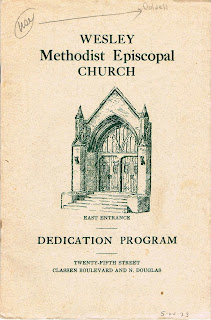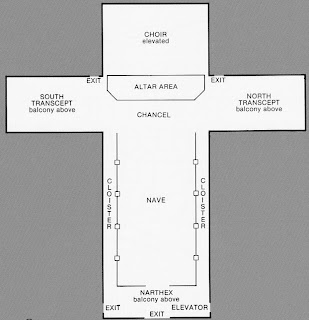
The university buildings first constructed on the NW 23rd street property was the towering administration building. Designed by architect William T. Schmitt of Oklahoma City, it faced NW 25 and reflected the collegiate gothic style.
When the Wesley sanctuary was rebuilt a few years later it too was concieved in the gothic collegiate style. Senior pastor Dr. Hovis suggested the design and layout and architects Leonard H. Baiiley and Virgil D. Alden of Baily and Alden Architectural firm drew the final plans.
it may be inferred that Dr. Hovis envisioned a close relationship between the closest Methodist church and the budding new incarnation of a Methodist academic institution in Oklahoma City. The school had begun its life in 1904 as Epworth University, moved to Guthrie as the Oklahoma Methodist University and then returned in 1919 to Oklahoma City. In that process other schools in Texas closed and transferred their records and programs to the newly named Oklahoma City University. It would be natural for Wesley to become the university church as such relationships were very common among institutions and the closest local church. That was exactly what happened as faculty and students attended Wesley, served on staff, and more than once Wesley people left to serve OCU.
In 1924, Dr. James W. Baker served as an OCU trustee while a preacher and district supertendent. He would later join Wesley.
M.M. Gibbens served as secretary of the OCU Trustees for many years.
C.S. McCreight and E.R. Stockwell also served as long time OCU Trustees.
In 1947, Myron Harris was awared an honorary degree by OCU for his faithful service on the OCU Board of Trustees. William "Bill" Harrison was a member of Trustee Advisory Committee on Finance.
In addition, at least four (4) OCU Presidents were members of Wesley Methodist Church. Over the years, many faculty also called Wesley their spiritual home.
The OCU Presidents
Edwin George Green, President 1919-1923
Dolphus Whitten Jr.
Aaron George Williamson, pastored wesley from 1933-34 and then served as OCU President beginning 1934
Jack S. Wilkes
The OCU Faculty
Clinton M. Allen
M.J. Binford
Dr. Nathan Boggs
Frank G. Brooks
Dr. Clarence Burg
Clifton Grossman
Harry H. Houser
D.M. Hart
J.C. Hoover
Leona Dale Hulet
John Lansing
Fred C. Meyer
Lena Misener
Francis McAlister
Wayde McAlister
Theron McGee
Therm T. Neilson
Nellie Melton
B.F. Nihart (Dean)
Oscar Lee Owens
T.F. Pierce
Acton Porter
Milton Prop
Campbell Russell
George Ryden
Mary Louise Simpson
Carrie Lee Snipes
Carl Skinner
Mr. and Mrs. Ralph Soule
Lena Smith
F.L. Tibbitts
Joe B. Thoburn
Norton Wey



























